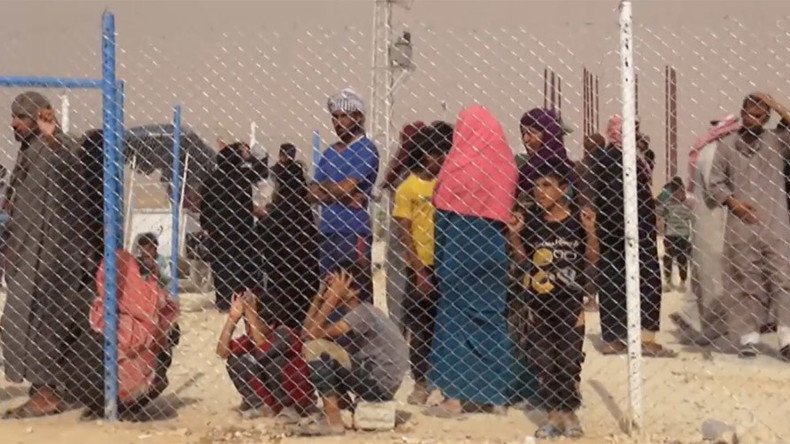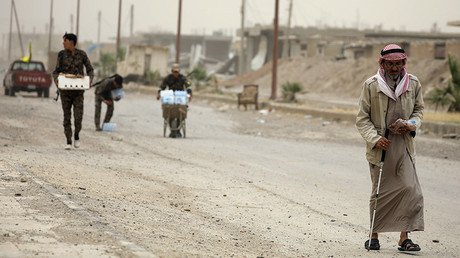‘Raqqa was a beautiful city, now it’s completely destroyed’ – Syrians lament cost of US bombing

US-led coalition airstrikes on Raqqa, an Islamic State stronghold in Syria, have claimed many civilian lives and forced tens of thousands to flee. RT’s Ruptly agency spoke to the displaced locals who described how the city was leveled in front of their eyes.
The ancient city of Raqqa, which has recently become known as the de-facto capital of Islamic State (IS, formerly ISIS/ISIL) terrorists in Syria, is currently under siege by the Syrian Democratic Forces (SDF), a Kurdish-led militia backed by the US-led coalition. The besieged city has come under heavy air bombardment while civilians have been trapped in IS-occupied neighborhoods, unable to escape.
The SDF on Wednesday said that “80 percent” of Raqqa has been retaken from IS and that the operation has moved into the final phase. At the same time, some SDF forces were seen being transferred away from the battlefield to the northern areas of the Deir ez-Zor province, according to the Russian Defense Ministry. The dislocation comes as the Syrian armed forces backed by Russian Air Force have been pushing out IS terrorists after liftking the siege of the city of Deir ez-Zor.
People in the Al-Mabrookeh refugee camp told Ruptly of the terrors they faced being caught in the middle of the fighting between IS terrorists and the US-backed SDF.
“The coalition launched heavy airstrikes over the residential areas and the nearby towns in the western and northern sectors, especially northward, where they targeted ISIS headquarters, and also locations where civilians were killed,” Ahmad Ibrahim told Ruptly.
“Schools, where students were studying, have been targeted as well. There was nothing there, and they have just been hit and destroyed,” he said.
Entire swathes of the city have been reduced to rubble by the bombing, which the UN estimates kills an average of 27 civilians each day.
“The aircraft was shelling, the aircraft of the coalition. Civilians – children and women – were killed. Raqqa is destroyed. It was a beautiful city, and it is totally destroyed. There is no Raqqa, nothing,” said a woman at the camp.
In some cases, militants tried to use civilians as human shields, purposefully attracting collateral damage on the terrified residents.
“During the ISIS siege, we were stopping our cars in front of the checkpoint, and when a member of ISIS heard the aircraft, he would stop the cars and not allow them to move. This was done so more civilians are killed,” said another refugee.
The coalition does not usually acknowledge mass-casualty civilian incidents, although in rare cases it launches investigations into them. Last week, the US-led coalition admitted to carrying out an airstrike in Deir ez-Zor province, which reportedly killed at least 12 Syrian civilians. The coalition promised to launch a probe into the incident, though it did not mention the casualties.
When reached for comment by RT, the coalition said the airstrike did take place, but targeted a terrorist unit in the area.
The circumstances around the airstrike seem to follow a common pattern indicating a glaring lack of intelligence on part of the US-led coalition, Ammar Waqqaf, the director of the Gnosos think tank, told RT.
“Since the start of the operations in Mosul we, I think, have lost count on how many times the United States wanted to hit an ISIS target and then suddenly there’s a huge massacre taking place,” Waqqaf said.
Earlier this month, the US-led coalition confirmed another 61 “unintentional civilian deaths” caused by its airstrikes in Iraq and Syria, raising the number of civilians it has acknowledged killing since 2014 to at least 685.
The deadliest incident was a March 14 strike near Mosul, Iraq, in which the coalition attacked an Islamic State position where militants were firing at coalition allies and 27 civilians were killed.
The coalition is currently investigating a total of 455 reports of civilian casualties caused by its artillery or airstrikes, the statement said. Between August 1 and 29, it conducted 1,094 airstrikes in and near the city of Raqqa – up from 645 in July.
The UN High Commissioner for Human Rights, Zeid Ra’ad Al Hussein, said in late August that the battle to regain Raqqa and Deir-ez-Zor from Islamic State must not be waged at the expense of the lives of civilians.
“Given the extremely high number of reports of civilian casualties this month and the intensity of the airstrikes on Raqqa, coupled with ISIL’s use of civilians as human shields, I am deeply concerned that civilians – who should be protected at all times – are paying an unacceptable price and that forces involved in battling ISIL are losing sight of the ultimate goal of this battle,” he said.













